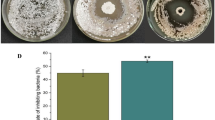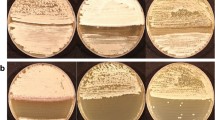Abstract
The pathogenicity of 10 bacterial isolates was investigated on potato, radish, carrot and beet, including sensitivity and pathogen control efficacy. The isolates were identified by morphological, biochemical and molecular methods. All isolates were pathogenic on radish, carrot, and beet, and were highly virulent on potato. Although the isolates were obtained from different locations in the El Fuerte Valley (Sinaloa, Mexico), they were similar in their morphological, physiological and biochemical characteristics. Sequences of the 16S rRNA gene obtained by PCR were identical for all isolates. These results indicate that the bacterial isolates from potato scabby tissue belong to S. acidiscabies. Furthermore, the effectiveness of fluazinam, both in vitro and under greenhouse and field conditions, represents a possible
option for chemical control of potato common scab disease. While our results suggest that spraying at seeding is effective in controlling common scab, future studies to combine this treatment with seed dressing before planting will be conducted to determine if there is an increase in disease control.
Resumen
Se investigó la patogenicidad de diez aislamientos bacterianos en papa, rábano, sanahoria y betabel, incluyendo la sensibilidad y la eficacia de control del patógeno. Se identificó a los aislamientos mediante métodos morfológicos, bioquímicos, y moleculares. Todos los aislamientos fueron patogénicos en rábano, zanahoria y betabel, y fueron altamente virulentos en papa. Aunque los aislamientos se obtuvieron de diferentes lugares en el Valle del fuerte (Sinaloa, México) fueron similares en sus características morflógicas, fisiológicas y bioquímicas. Las secuencias del gen 16S rRNA obtenidas por PCR fueron idénticas para todos los aislamientos. Estos resultados indican que los aislamientos bacterianos de tejido de la roña en papa pertenecen a S. acidiscabies. Aún más, la efectividad de fluazinam, tanto in vitro como bajo condiciones de invernadero y campo, representa una opción posible para el control químico de la enfermedad de la roña común en papa. Mientras que nuestros resultados sugieren que la aspersión en la siembra es efectiva en el control de la roña común, se conducirán estudios a futuro para combinar este tratamiento con cubrimiento a la semilla antes de la siembra para determinar si hay un aumento en el control de la enfermedad.


Similar content being viewed by others
References
Anderson, A.S., and E.M. Wellington. 2001. The taxonomy of Streptomyces and related genera. International Journal of Systematic and Evolutionary Microbiology 51: 797–814.
Bjor, T., and L. Roer. 1980. Testing the resistance of potato varieties to common scab. Potato Research 23: 33–47.
Bouchek-Mechiche, K., L. Gardan, P. Norman, and B. Jouan. 2000. DNA relatedness among strains of Streptomyces pathogenic to potato in France: descrption of three new species, S. europeiescabiei sp.nov. and S. stelliscabiei sp. nov. associated with common scab and S. reticuliscabiei associated with netted scab. International Journal of Systematic and Evolutionary Microbiology 50: 91–99.
Bukhalid, R.A., T. Takeuchi, D. Labeda, and R. Loria. 2002. Horizontal transfer of the plant virulence gene, nec1, and flanking sequences among genetically distinct Streptomyces strains in the Diastatochromogenes cluster. Applied and Environmental Microbiology 68: 738–744.
Chen, W.P., and T.T. Kuo. 1993. A simple and rapid method for the preparation of gram-negative bacterial genomic DNA. Nucleic Acids Research 21: 22–60.
Conover, W.J. 1999. Practical nonparametric statistics. New York: John Wiley & Sons, Inc..
Cullen, D.W., and A.K. Lees. 2007. Detection of the nec1 virulence gene and its correlation with pathogenicity in Streptomyces species on potato tubers and in soil using conventional and real-time PCR. Journal of Applied Microbiology 102: 1082–1094.
Davis, J.R., and R.H. Callihan. 1971. Effects of fungicide treatment on tuber quality, scab and Rhizoctonia control of russet Burbank potato. American Potato Journal 48: 295–308.
Davis, J.R., G.M. McMaster, R.H. Callihan, F.H. Nissley, and J.J. Pavek. 1976. Influence of soil moisture and fungicide treatments on common scab and mineral content of potatoes. Phytopathology 66: 228–233.
De, B.K., and P.C. Sengupta. 1993. Chemical control of common scab of potato. Journal of the Indian Potato Association 20: 273–274.
Doering-Saad, C., P. Kampfer, S. Manulis, G. Kritzman, J. Schneider, J. Zakrzewskaczerwinska, H. Schrempf, and I. Barash. 1992. Diversity among Streptomyces strains causing potato scab. Applied and Environmental Microbiology 58: 3932–3940.
Edgar, R.C. 2004. MUSCLE: multiple sequence alignment with high accuracy and high throughput. Nucleic Acids Research 32: 1792–1797.
Faucher, E., E. Paradis, C. Goyer, N.C. Hodge, R. Hogue, R.E. Stall, and C. Beaulieu. 1995. Characterization of Streptomyces causing deep-pitted scab of potato in Québec, Canada. International Journal of Systematic Bacteriology 45: 222–225.
Felsenstein, J. 1985. Confidence limits on phylogenies: an approach using the bootstrap. Evolution 39: 783–791.
Gomez, K.A., and Gomez, A.A. 1984. Statistical procedures for agricultural research. Second Edition. United States of America. John Wiley Sons Inc. 680 p.
Goyer, C., and C. Beaulieu. 1997. Host range of Streptomycete strains causing common scab. Plant Disease 81: 901–904.
Healy, F.G., and D.H. Lambert. 1991. Relationships among Streptomyces spp causing potato scab. International Journal of Systematic Bacteriology 41: 479–482.
Hill, J., and G. Lazarovits. 2005. A mail survey of growers to estimate potato common scab prevalence and economic loss in Canada. Canadian Journal of Plant Pathology 27: 46–52.
Hooker, W.J. 1981. Compendium of potato disease, 33–34. St. Paul: American Phytopathological Society.
Hosny, M., K.A.M. Abo-Elyousr, M.R. Asran, and F.A. Saead. 2014. Chemical control of potato common scab disease under field conditions. Archives of Phytopathology and Plant Protection 47: 2193–2199.
Janse, J.D. 1998. A Streptomyces species identified as the cause of carrot scab. Netherlands Journal of Plant Pathology 94: 303–306.
Kimura, M. 1980. A simple method for estimating evolutionary rates of base substitutions through the comparative studies of sequence evolution. Journal of Molecular Evolution 16: 111–120.
Kirk, W.W. 2015. Introduction to 2013 symposium on bacterial diseases of potatoes. American Journal of Potato Research 92: 215–217.
Koenraad, F.M., B. Tierens, M.B. Thomma, S. Jurgen, K. Kistner, A. Porzel, B. Mauch-Mani, P.A. Cammue, and W.F. Broekaert. 2001. Study of the role of antimicrobial glucosinolate-derived isothiocyanates in resistance of Arabidopsis to microbial pathogens. Plant Physiology 125: 1688–1699.
Kreuze, J.F., S. Soumalainem, L. Paulin, and J.P.T. Valkonen. 1999. Phylogenetic analysis of 16S rRNA genes and PCR analysis of the nec1 gene from Streptomyces spp. causing common scab, pitted scab and netted scab in Finland. Phytopathology 89: 462–469.
Lambert, D.H. 1991. First report of additional hosts for the acid scab pathogen Streptomyces acidiscabies. Plant Disease 75: 750.
Lambert, D.H., and R. Loria. 1989a. Streptomyces scabies sp. nov., nom. rev. International Journal of Systematic Bacteriology 39: 387–392.
Lambert, D.H., and R. Loria. 1989b. Streptomyces acidiscabies sp. nov. International Journal of Systematic Bacteriology 39: 393–396.
Lapwood, D.H. 1972. The relative importance of weather, soil and seed-borne inoculum in determining the incidence of common scab (S. scabies) in potato crops. Plant Pathology 21: 105–108.
Lehtonen, M.J., H. Rantala, J.F. Kreuse, H. Bang, L. Kuisma, P. Koski, E. Virtanen, K. Vihlman, and J.P.T. Valconen. 2004. Occurrence and survival of potato scab pathogens (Streptomyces scabies) on tuber lesions: quick diagnosis based on PCR-based assay. Plant Pathology 53: 280–287.
Lerat, Y., A.M. Simao-Beaunoir, and C. Beaulieu. 2009. Genetic and physiological determinants of Streptomyces scabies pathogenicity. Molecular Plant Pathology 10: 579–585.
Levick, D.R., T.A. Evans, C.T. Stephens, and M.L. Lacy. 1985. Etiology of radish scab and its control through irrigation. Phytopathology 75: 568–572.
Leyva-Mir, S.J., F. Garay-Lizarraga, O.G. Alvarado-Gomez, L.E. Castillo-Marquez, and J.M. Tovar-Pedraza. 2014. Detección y control de Streptomyces scabies en tubérculos de papa (Solanum tuberosum L.) en el valle del Mayo, Sonora, México. Chilean Journal of Agriculture & Animal Science, ex Agro-Ciencia 30: 5–13.
Little, T.M., and F.J. Hills. 1973. Agricultural experimentation and analysis, 350. New York: John Wiley and Sons.
Locci, R. 1994. Actinomycetes as plant pathogens. European Journal of Plant Pathology 100: 179–200.
Loria, R., R.A. Bukhalid, B.A. Fry, and R.R. King. 1997. Plant pathogenicity in the genus Streptomyces. Plant Diseases 81: 836–846.
Loria, R., J. Kers, and M. Joshi. 2006. Evolution of plant pathogenicity in Streptomyces. Annual Review of Phytopathology 44: 469–487.
Manzer, F.E., G.A. McIntyre, and D.C. Merriam. 1977. A new potato scab problem in Maine. Maine Life Science Agriculture Experiment Station Bulletin. 85: 1–24.
Mishra, K.K., and J.S. Srivastava. 2001. Screening potato cultivars for common scab of potato in naturally infested soil. Potato Research 44: 19–24.
Mishra, P.K., D. Mishra, J.K. Dhal, and P.K. Chhotaray. 1991. Control of common scab of potato by seed tuber treatment. Orissa Journal of Agriculture Research 4: 120–121.
Miyajima, K., F. Tanaka, T. Takeuchi, and S. Kuninaga. 1998. Streptomyces turgidiscabies sp. nov. International Journal of Systematic Bacteriology 48: 495–502.
Monciardini, P., M. Sosio, L. Cavaletti, C. Chiocchini, and S. Donadio. 2002. New PCR primers for the selective amplification of 16S rDNA from different groups of actinomycetes. FEMS Microbiology Ecology 42: 419–429.
Park, D.H., Y.M. Yu, J.S. Kim, J.M. Cho, J.H. Hur, and C.K. Lim. 2003. Characterization of Streptomycetes causing potato common scab in Korea. Plant Disease 87: 1290–1296.
Pung, H., and S. Cross. 2000. Common scab incidence on seed potatoes, and seed-borne disease control. Conference Proceedings of potatoes. 31th July-3th August. Adelaide, South Australia.
Rete-Corral, A. 2011. Tesis de Maestría. Centro Interdisciplinario de Investigación para el Desarrollo Integral Regional. Sinaloa: Guasave.
Saitou, N., and M. Nei. 1987. The neighbor-joining method: a new method for reconstructing phylogenetic trees. Molecular Biology and Evolution 4: 406–425.
Schaad, N.W., J.B. Jones, and W. Chun. 2001. Laboratory guide for identification of plant pathogenic bacteria, 164 p. St. Paul. Third edition: APS Press.
Sebaugh, J.L. 2011. Guidelines for accurate EC50/IC50 estimation. Pharmaceutical Statistics 10: 128–134.
Shirling, E.B., and D. Gottlieb. 1966. Methods for characterization of Streptomyces species. International Journal of Systematic Bacteriology 16: 313–340.
Singh, H., and P.S. Soni. 1987. Chemical control of common scab of potato. Plant Disease Research 2: 77–79.
Slack, S.A. 1991. A look at potato leafroll virus and potato virus Y: past, present, future. Badger Common Tater 43: 16–21.
Song, J., S.-C. Lee, J.-W. Kang, H.-J. Baek, and J.-W. Suh. 2004. Phylogenetic analysis of Streptomyces spp. isolated from potato scab lesions in Korea on the basis of 16S rRNA gene and 16S–23S rDNA internally transcribed spacer sequences. International Journal of Systematic and Evolutionary Microbiology 54: 203–209.
Stead, D., and S. Wale. 2004. Non-water control measures for common scab. Research Review. British Potato Council R248: 49pp.
Takeuchi, T., H. Sawada, F. Tanaka, and I. Matsuda. 1996. Phylogenetic analysis of Streptomyces spp. causing potato scab based on 16S rRNA sequences. International Journal of Systematic Bacteriology 46: 476–479.
Tamura, K., G. Stecher, D. Peterson, A. Filipski, and S. Kumar. 2013. MEGA6: molecular evolutionary genetics analysis version 6.0. Molecular Biology and Evolution 30: 2725–2729.
Tashiro, N., K. Miyashita, and T. Suzui. 1990. Taxonomic studies on the Streptomyces species isolated as causal organisms of potato common scab. Annals of the Phytopathological Society of Japan 56: 73–82.
Wanner, L.A. 2004. Field isolates of Streptomyces differ in pathogenicity and virulence on radish. Plant Disease 88: 785–796.
Wanner, L.A. 2007. A new strain of Streptomyces causing common scab in potato. Plant Disease 91: 352–359.
Wanner, L.A. 2009. A patchwork of Streptomyces species isolated from potato common scab lesions in North America. American Journal of Potato Research 86: 247–264.
Wanner, L.A., and W.W. Kirk. 2015. Streptomyces-from basic microbiology to role as a plant pathogen. American Journal of Potato Research 92: 236–242.
Wiechel, T.J., and Crump, N.S. 2010. Soil nutrition and common scab disease of potato in Australia. 19th world Congress of soil science, soil solutions for a changing world. 1–6 August 2010. Brisbane, Austalia. 237-240.
Wilson, C.R., L.M. Ramson, and B.M. Pemberton. 1999. The relative importance of seed-borne inoculum to common scab disease of potato and the efficacy of seed tuber and soil treatments for disease control. Journal of Phytopathology 147: 13–18.
Author information
Authors and Affiliations
Corresponding author
Rights and permissions
About this article
Cite this article
Santos-Cervantes, M.E., Felix-Gastelum, R., Herrera-Rodríguez, G. et al. Characterization, Pathogenicity and Chemical Control of Streptomyces acidiscabies Associated to Potato Common Scab. Am. J. Potato Res. 94, 14–25 (2017). https://doi.org/10.1007/s12230-016-9541-5
Published:
Issue Date:
DOI: https://doi.org/10.1007/s12230-016-9541-5




